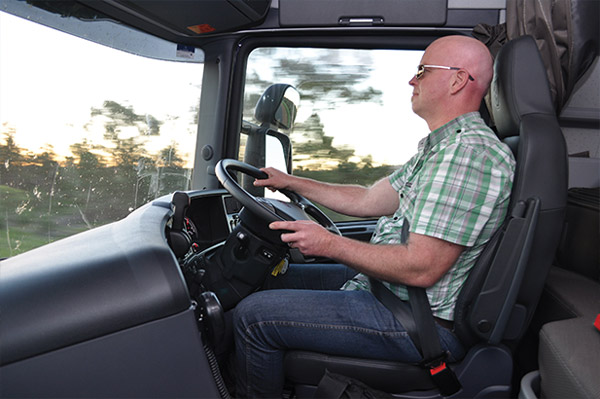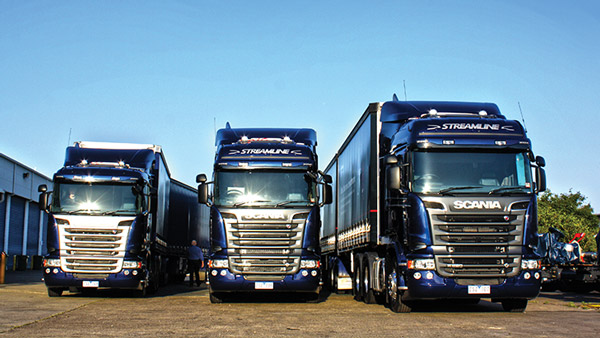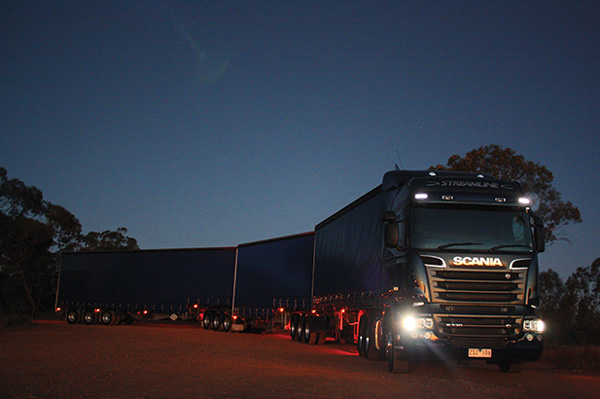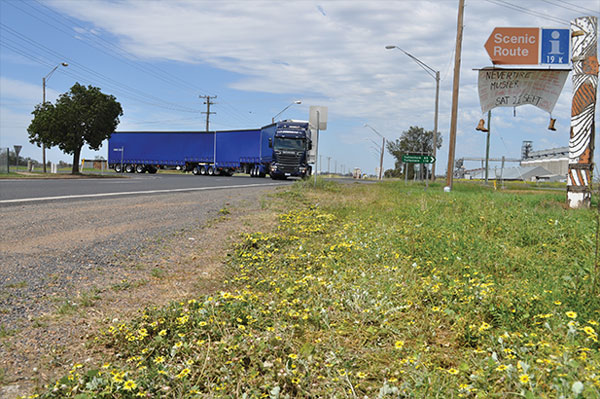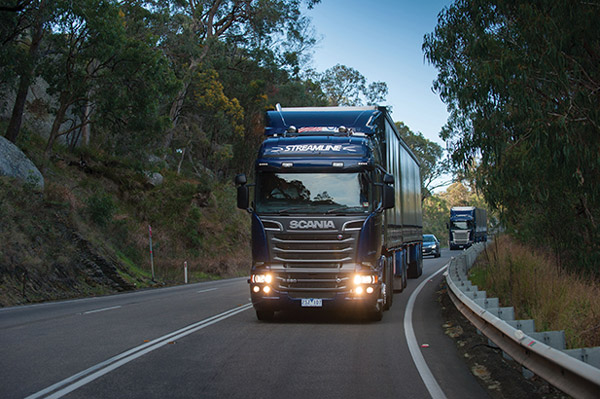The big Scania R730 eats up the road and while its brothers might be smaller, they also show they have the right spirit
Engine
Scania Trucks has raised the bar in the horsepower stakes with the Euro 5-compliant R730, which assumes the mantle of the world’s most powerful truck.
The 730hp (544kW) model runs a V8 engine that boasts a huge 3,500Nm rating of torque.
The smaller R620 also runs a 16-litre V8 with SCR configuration but, as the name suggests churns out 620hp (456kW) and a 3,000Nm rating of torque.
The baby in the range, the R480, has a 13-litre 6-cylinder engine with SCR and pumps out 480hp (353kW) and 2,400Nm of torque.
Transmission
All three models, the R730, R620 and R480, all ship with 14-speed Opticruise AMT transmissions. The gearboxes include two crawler gears.
Cab and Controls
The Streamline facelift has seen a smoother rounder visage for the R Series and G Series cabs.
The cab corners now have a small deflector lip to keep spray and dirt off the mirrors, the driving lights are smaller and have been recessed into the sun visor and the ends of the visor have been opened up in an effort to make the cab more slippery and aerodynamic.
It does look a little different but, unfortunately, by European standards, it is starting to look a little dated.
All of the European brands now have new cabs and in some cases completely new platforms waiting in the wings. For the R Series, however, this is as good as it gets cosmetically at least for the foreseeable future.
Performance
This is the new Streamline version of the big Swede and I’m at the front, in fact now a long way in front, of a little Streamline convoy that is made up of the big flagship 730, the R620 and the R480, all are towing B-doubles.
We’ve left Brisbane to head for Melbourne, via the New England Highway but we’re going to take a bit of a diversion along the way.
We’re going to stick another trailer behind the R730 at Gilgandra and try the V8 as a B-triple combination on some of the New South Wales road train and triple network and see how the mildly face lifted and aerodynamically tweaked R Series goes with an extra trailer on its back at nearly 80 tonnes gross.
But, before that happens I’ll have to relinquish my station at the helm of the most powerful on-road truck currently sold in this country. Because unfortunately, I have to play nice and share and I’m not very good at either.
This first stage sees me humming along in the big banger as we head down the New England Highway towards Tamworth.
However, a reality check is in store and a break at Glen Aplin sees me relocated into the selective catalytic reduction (SCR) 6-cylinder R480. And boy is it a long way to fall. The ‘little’ 480 is a game performer but struggles in the hills at close to maximum gross B-double weight.
This little jigger is a part-time B-double or diminishing load type vehicle in my opinion.
In fact in this convoy, the 480 is kind of like a mate’s younger brother who keeps tagging along wanting to play but who has trouble keeping up.
In the R480, I have to turn down the aircon, wind up the windows and harness the earth’s gravitational pull to make a mile, but our next stop sees me step out of the 6-banger and back into a V8, this time the 620.
This is probably the truck that makes the most sense as an Aussie heavy hauler for Scania. Okay, the big brother has the kudos, but along with the 620 ponies comes 2,213ft-lb of silky torque, which is cranked out in an ultra-smooth, characteristically V8 fashion.
These days you may not be able to hear much of the V8 burble of old but you can sure as hell feel it underfoot as it feeds power to the drive wheels.
The New England Highways’ bumps, bangs and undulations don’t faze the 620 one bit, and it also brings out the best in Scania’s retardation department.
I try and shy away from making stupid blanket statements … most of the time, but, the gearbox mounted hydraulic retarder would have to be the best retardation on a European driveline that I’ve come across.
The retarder is actuated by pulling the transmission selector wand around on the steering column it can be a little counterintuitive to use at first if you’re used to flicking the switch on a Jake brake.
But the upside is that it doesn’t make the engine wail like a toddler on a descending aeroplane when you’re using it.
In fact. it’s extremely quiet. The telltale hiss of the exhaust brake and distant whine of the retarder are in the background as this impressive bit of gear does its best work.
However, to get the best out of the Scania both in terms of performance and economy, a bit of driver coaching never goes astray.
Scania driver trainers Lindsay Pollock and Alan McDonald were along for the ride and their tips were invaluable as I got to pick their brains along the way. The reason being is you have to slide into the Scania mindset to really get the best out of the vehicle.
Just because the R Series has a 12-speed automated Opticruise transmission doesn’t mean it’s easy to drive.
It’s easy to drive badly, just select D and put the foot to the floor. But because the V8 drivelines put out so much power and torque, but so smoothly and quietly; it can be easy to forget just how much work the truck is doing and how fast the truck is going.
I noticed this on a couple of occasions as I was bleeding speed off to turn a corner or pull into a rest area.
I really noticed this when it came to descending “The Moonbies” (Moonbie Range) just north of Tamworth. In a Yank-powered truck, I’d put the stick in first gear top box and run down on the Jake with a few stabs of the brake when needed. In the Scania, I actually came over the top a little quick, lulled into a false sense of security by the lack of noise.
As a result, I had to try and pull back some more speed while descending the first pinch, the retarder did an awesome job of holding it back but I manually down-changed one cog too many and ran the 620 down higher in the rev range than I would’ve liked.
And that’s the danger of thinking these trucks are an easy shortcut for getting inexperienced drivers out on the highway.
Anyone can make one move, but the laws of physics still apply, they are still big, heavy and powerful lumps of steel that will cost an owner a lot of money if they aren’t used properly.
After overnighting in Gunnedah, our posse set off south towards the Newell Highway and the town of Gilgandra where the 480 was going to lose a trailer and the 730 was going to gain one.
I climbed behind the wheel of the three trailered R730 at the hamlet of Nevertire after another stint in the 620 and, surprise, surprise, there wasn’t a great deal of difference between the 730 as an 80-tonne B-triple combination and the 620 as a 60-tonne B-double.
It was that easy it was almost underwhelming.
The opening of the Holbrook bypass on the Hume Highway in NSW has brought the B-triple conversation back into the spotlight recently. There’s now more talk of trials and it seems it’s a matter of, rather than when, High Productivity Vehicles (HPV’s) will be granted permission to ply the now completely duplicated Hume Freeway.
This role would undoubtedly play to Scania’s strengths and perhaps downplay some of the weaknesses that come from selling a European truck under our current ADR regime.
Scania’s prodigious power output has always been hampered in Oz by a relatively low fuel capacity, which is now up to 1,030 litres.
This is still considered by most to be nowhere near enough for most high-horsepower long distance applications, especially if a company is using their own depot bowsers for refuelling at wholesale fuel prices.
But to get more fuel onto the R Series chassis would push the big banger over weight on the steer axle, Australia’s 6.5-tonne concessional steer axles mass (6.7 in Western Australia) discriminates heavily against all of the European brands pretty much without exception.
The European Union (EU) doesn’t restrict steer axle weights considering if the vehicle is legal on the drive and the trailer axles it won’t be dramatically heavy over the steer.
However, for an 830km shuttle run up the Hume Freeway fuel capacity wouldn’t be an issue and all of that Scania V8 torque would come in very handy on some of those big pulls.
But, as for me out on the Mitchell Highway and Barrier Highway’s heading towards Cobar in Western NSW the big Swede rumbles along at the legal 90km/h triple limit and through the undulating landscape easily.
While the cab may be looking a little long in the tooth getting off the major highways highlights another of the Scania’s strong points; handling and ride on less than ideal road surfaces.
The B-triple combination is extremely stable on the open road but the further west you head, the steeper the camber on the road and the more crumbled away the road edge gets.
The R Series gets away with enough comfort to save the kidneys but enough feel through the wheel to let the driver know what’s going on out there.
Another point where the Euro manufacturers are often criticised is the nod and sway of their suspended cabs and Scania have managed to straddle the line between comfort and feel without the floppy feeling that has traditionally been associated with Euro cab off the beaten track.
This all helps keep the three trailer combination on the straight and narrow easily, and the tag trailer hardly moves on the roughest of surfaces.
Cobar sees me ejected from the 730 yet again and back behind the wheel of the 480. But, now running as a single the little R Series is a different beast all together and as the smallest vehicle in the convoy now serves as a camera platform and as a lunch wagon.
Night falls on the road to Hillston and the amount of roos appearing out of the road-side gloom mean we have to back off our speed a bit. None of the trucks are fitted with roo bars so a decent sized marsupial will no doubt cause quite a bit of damage as well as some more painful consternation.
However, we make it to Hillston without damaging any wildlife and the folks at the pub were even kind enough to keep the kitchen open for us.
Nice place, Hillston.
After leaving the next morning on the short run back into Melbourne, I find myself contemplating the tweaks, some subtle, some not so subtle that have brought the R Series to where it is today.
The new low-drag Opticruise transmission has less oil capacity and new guide plates which, in turn, reduces friction and drag on the driveline. But to be honest I was struggling to notice any major difference out on the road.
The new premium seating by Recaro is extremely comfortable though with more adjustments than you can poke a stick at, as well as heating and ventilation. There’s even an internal fan to reduce the incidence of sweaty butt-crack syndrome (SBCS).
Verdict
Scania claim the Streamline upgrade will result in a potential fuel saving of 3 per cent.
As the R Series shed has already proven itself as a Euro 6 platform in Europe, it’s perhaps understandable the marque is reluctant toinvest in a new platform unnecessarily.
Vehicle optimisation is the new black at Scania and the Streamline is the direct result of this.
Streamline or not the R Series is a great truck, especially in V8 form, and you tend to be prepared to overlook some of its shortcomings as a result.
The engine and transmission package, as well as the retarder, make the V8 a rewarding bit of gear to operate.
The novelty never wears off doing standing hill starts in a loaded B-triple and watching the gears climb perfectly on take-off. For me it always comes back to the power plant and there happens to be 730 reasons to like the Scania flagship and 620 reasons just in case you miss out.
Specifications
Make/Model: Scania R Series Streamline V8-Highline Cab
Engine: 8-cylinder 16-litre V8 configuration with SCR
Power: R730: 730hp (537kW). R620: 620hp (456kW)
Torque: R730: 2581ft-lb (3,500Nm) @ 1,000 to 1,400rpm. R620: 2,213ft-lb (3,000Nm) @ 1,000 to 1,400rpm
Transmission: 14-speed (12+2 crawler gears) Opticruise AMT
Fuel Capacity: 1,030 litres
DEF Capacity: 75 litres
Braking: Discs all-round with ABS and electronic braking system (EBS)
GVM: Dependent on specification
Make/Model: Scania R480 Streamline standard height sleeper cab
Engine: In-line 13-litre 6-cylinder with SCR
Power: 480hp (353kW)
Torque: 2,400Nm @ 1,000 to 1,300rpm
Transmission: 14-speed (12+2 crawler gears) Opticruise AMT
Fuel capacity: 850 litres
DEF Capacity: 75 litres
Braking: Discs all round with ABS and EBS
GVM: Dependent on specification

